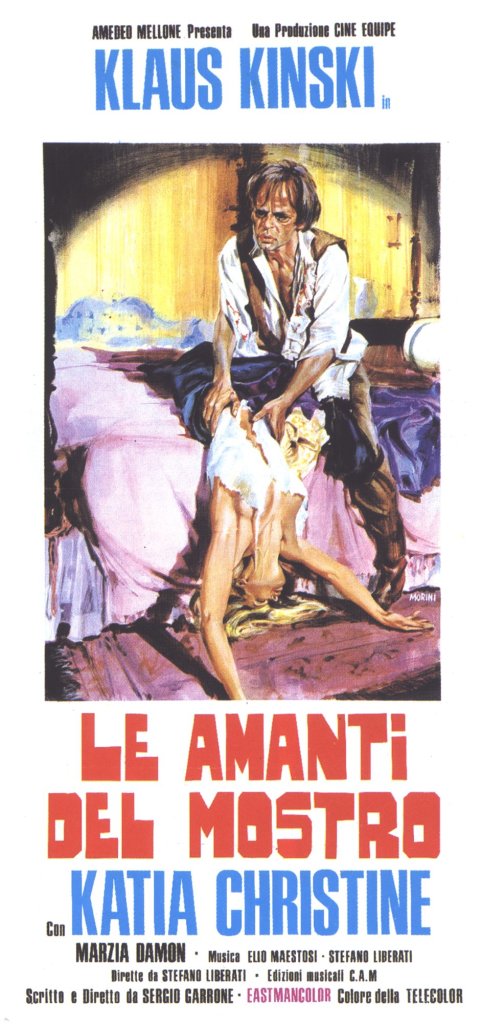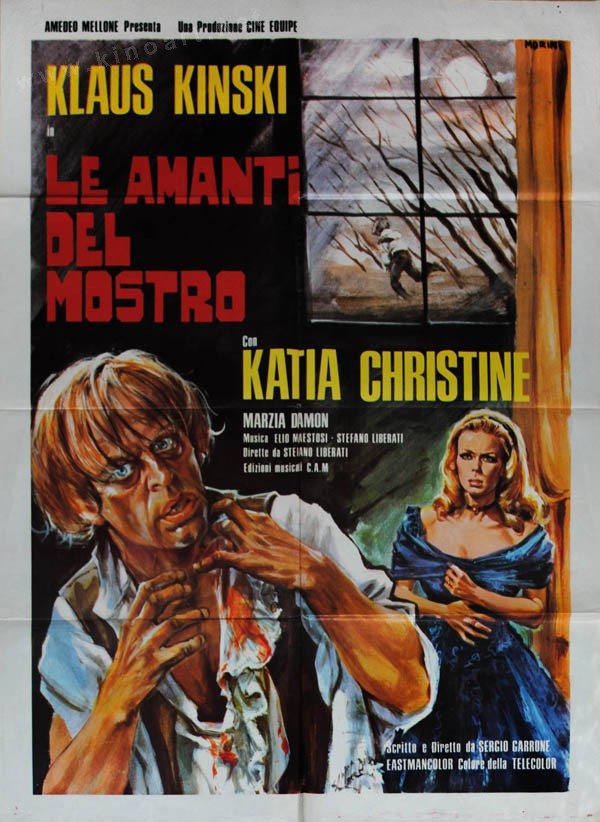Dir: Sergio Garrone
Star: Klaus Kinski, Katia Christine, Ayhan Isik, Erol Tas
a.k.a. Le Amanti del Mostro
 Watching this, it struck me that Kinski would have been a good alternative to Udo Kier in the same year’s Flesh for Frankenstein. For this Italian/Turkish co-production starts off looking like it’s going to be another version of the Frankenstein story, with Alex Nijinski (Kinski) and his wife Anna (Christine), moving into the rural mansion which was her late father’s home, as well as his laboratory. Alex becomes increasingly fascinated by the experiments carried out by his father-in-law, and starts to return the laboratory to its former, functioning state, unaware – or not caring – that his wife is being wooed by an old flame, local Doctor Igor Walensky (Isik). When her pet dog turns up dead, Alex seizes the chance to try out the lab equipment and…
Watching this, it struck me that Kinski would have been a good alternative to Udo Kier in the same year’s Flesh for Frankenstein. For this Italian/Turkish co-production starts off looking like it’s going to be another version of the Frankenstein story, with Alex Nijinski (Kinski) and his wife Anna (Christine), moving into the rural mansion which was her late father’s home, as well as his laboratory. Alex becomes increasingly fascinated by the experiments carried out by his father-in-law, and starts to return the laboratory to its former, functioning state, unaware – or not caring – that his wife is being wooed by an old flame, local Doctor Igor Walensky (Isik). When her pet dog turns up dead, Alex seizes the chance to try out the lab equipment and…
Well, and that’s where the film makes an abrupt right-turn, into the street which is home to another classic of 19th-century horror literature, Robert Louis Stevenson’s Doctor Jekyll and Mister Hyde. For, while attempting to resurrect the pooch, Alex gets a shock – no, literally, since part of the machine, which relies on high-voltage electricity for its power, malfunctions and sends its energy into its operator. For reasons never satisfactorily explained or explored, that turns him into a part-time maniac, roaming the countryside and killing anyone unfortunate enough to cross his path. When the dead bodies start turning up, the local authorities choose to blame any conveniently handy vagabonds. One innocent man is lynched, and after the murders continue unabated, another gets hauled in for a show trial which would make Stalin shuffle uncomfortably. Meanwhile, it’s just starting to dawn on Alex what’s happening during his blackouts.
It’s obviously a good role for Kinski, who gets both to be restrained and subdued (particularly by his standards) as Alex, then is given free rein to go totally over-the-top and let rip as the monster. Initially, it isn’t clear Alex is the culprit, with most of the monster’s early attacks being shown from its point of view, which seems like a waste of Kinski’s talents to me. There’s a strange tension to the relationship between Alex and Anna, apparent upon their arrival, when she shows him to her father’s room, then declares, “My room is in the other wing of the house.” It’s mentioned on occasion that the source of the tension is his possessiveness, Alex saying, “I’ll try to make you forgive my moments of jealousy,” and at another point, Anna says, “Your absurd jealousy offended me.” However, there’s never any specifics provided, and its an angle which doesn’t go anywhere, even though it seems to be Alex’s ongoing love for Anna, which propels things to their final, tragic conclusion.
 The production values are solid, and it has some of the same lush cinematographic feel enjoyed by the better Hammer Productions of the sixties, even if the music largely consists of the same cue, used almost regardless of whether or not its appropriate. Beyond Kinski, the cast are solid, rather than memorable: neither Christine nor Isik have much to do or show any real character arc. It’s remarkably restrained in the exploitation aspects: the killings are positively bloodless, and up until the end, when Christine does her best to make up for lost time, there’s no nudity to speak of either. That’s surprising for two reasons. Firstly, the sex/horror combination genre was well under way by this point – not least at the hands of Hammer – and secondly, Garrone was hardly averse to the sleazier aspects of cinema. To demonstrate that, in his filmography, this comes in between writing The Big Bust Out, a.k.a. Crucified Girls of San Ramon, and his best known directorial work, the Naziploitation entry, S.S. Experiment Camp.
The production values are solid, and it has some of the same lush cinematographic feel enjoyed by the better Hammer Productions of the sixties, even if the music largely consists of the same cue, used almost regardless of whether or not its appropriate. Beyond Kinski, the cast are solid, rather than memorable: neither Christine nor Isik have much to do or show any real character arc. It’s remarkably restrained in the exploitation aspects: the killings are positively bloodless, and up until the end, when Christine does her best to make up for lost time, there’s no nudity to speak of either. That’s surprising for two reasons. Firstly, the sex/horror combination genre was well under way by this point – not least at the hands of Hammer – and secondly, Garrone was hardly averse to the sleazier aspects of cinema. To demonstrate that, in his filmography, this comes in between writing The Big Bust Out, a.k.a. Crucified Girls of San Ramon, and his best known directorial work, the Naziploitation entry, S.S. Experiment Camp.
Perhaps the most unusual aspect is the socio-political one. The authorities fail to consider, even for a moment, the possibility that the killer could be a member of the local upper classes. Instead, they just naturally blame a tramp, and execute the first one they find, with little more concern than “I hope we found the right man or it would be a terrible mistake,” hand-waving away such concerns with “No-one in town could have done something similar… I think I can consider the case closed.” Then, when Alex’s murderous spree continues, and proves them wrong, it’s decided that the basic principle was fine, they just didn’t quite get the right vagrant. And the next one actually has blood on his hands! Never mind his “absurd assertions” that this is the result of a chicken he stole, “It’s enough to look into his eyes to be convinced of his offense.” It’s very clear Garrone does not have a great opinion concerning the fairness to be found in the legal and judicial systems.
Garrone had worked, at least tangentially, with Kinski before, having written the story that became 5 per l’inferno. And he worked with him again immediately, since this was also shot alongside/back-to-back with The Hand That Feeds the Dead (a.k.a. Evil Face). [The two are often confused: they have virtually the same cast and make use of the location, and similar premises, Kinski playing a mad scientist in both.] This is respectable enough as drama. anchored by the expected strong performance from Kinski. However, it definitely needs the rest of the film to be ramped up to match, coming over as too genteel to be particularly memorable, and feeling a good decade older than its actual age.